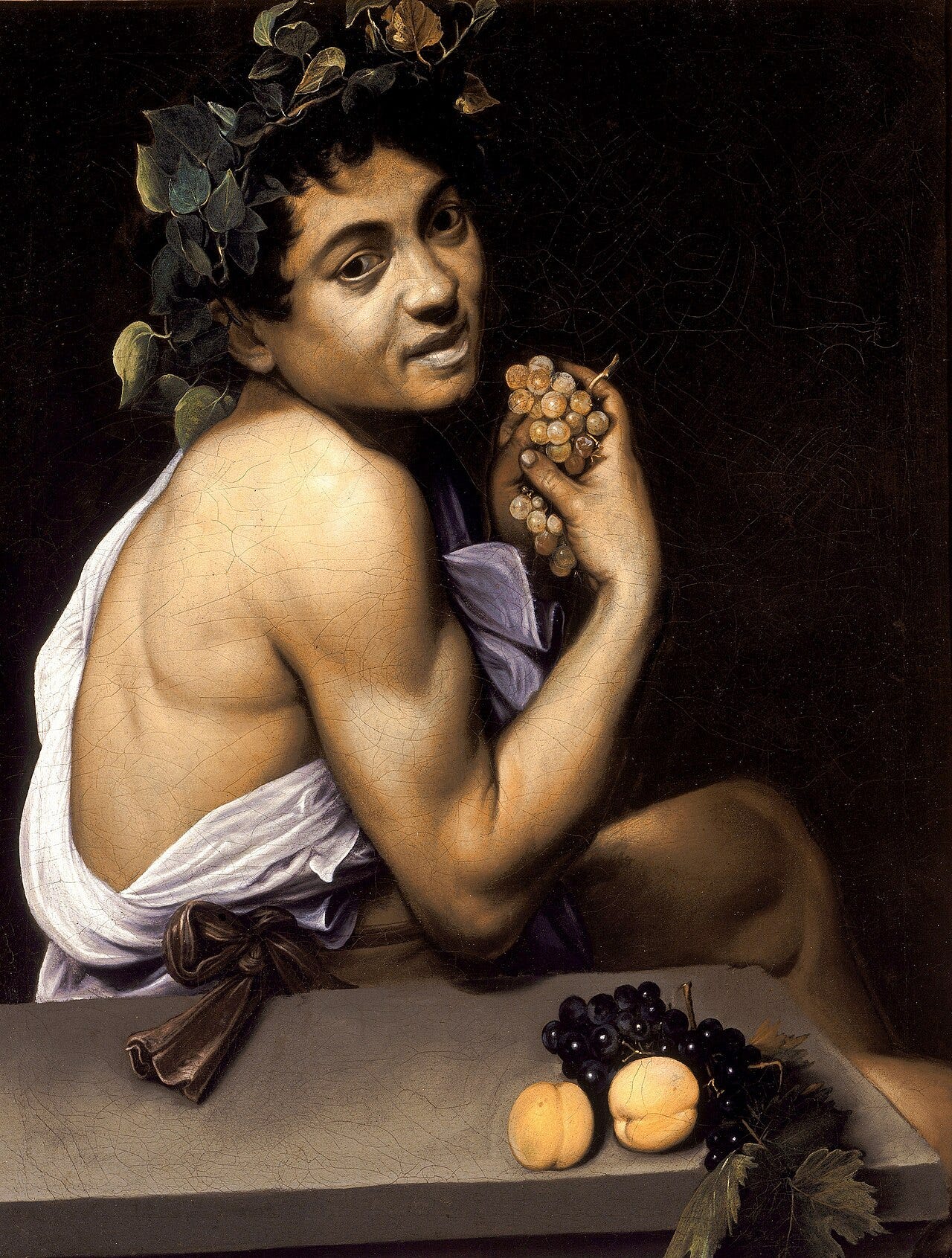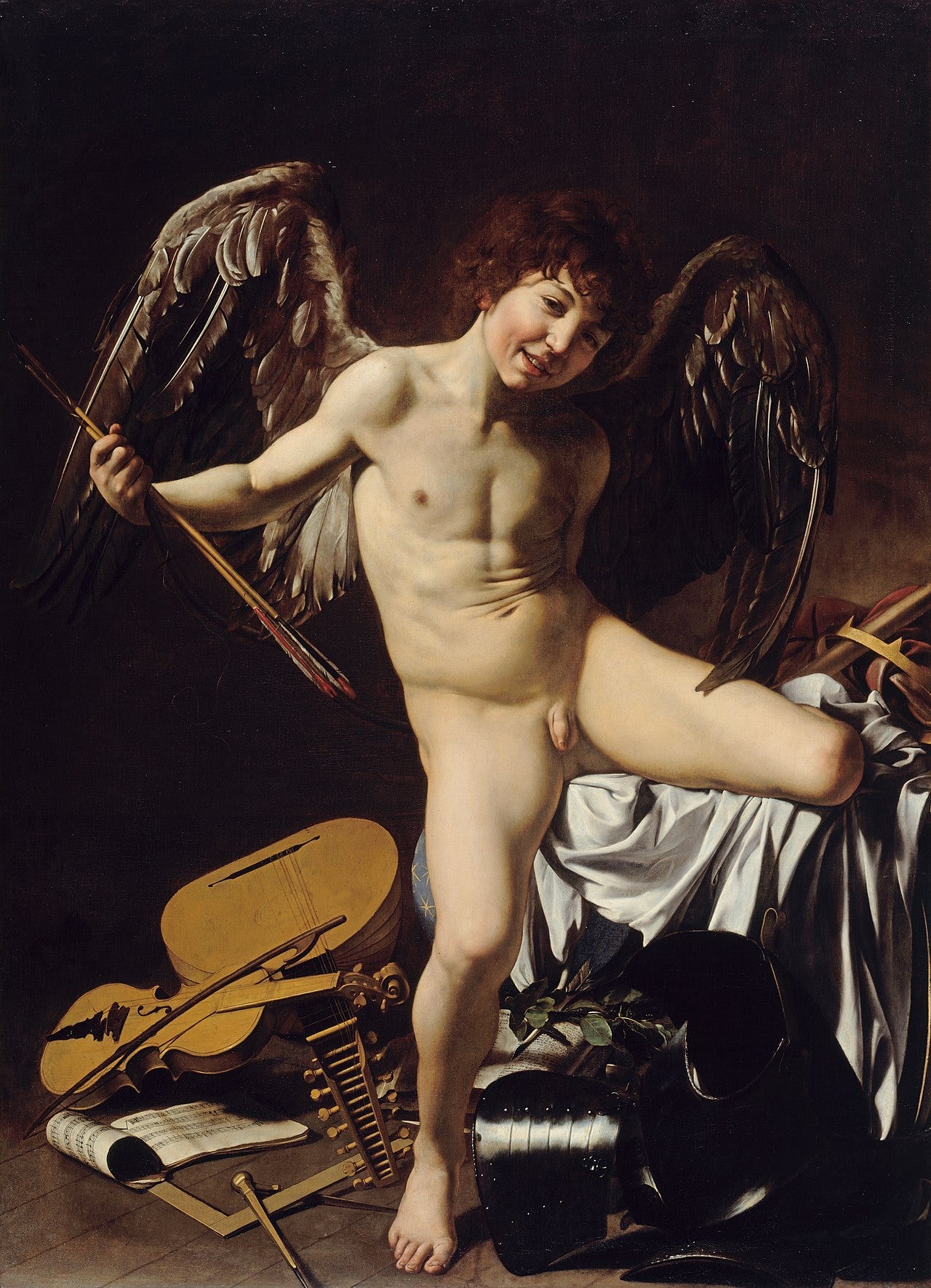Michelangelo Merisi da Caravaggio (1571–1610) stands as one of the most innovative and controversial figures in Baroque art. While his revolutionary use of chiaroscuro and commitment to naturalistic representation have been widely acknowledged, contemporary scholarship has increasingly explored the homoerotic and emotionally charged elements of his oeuvre. Though Caravaggio never publicly disclosed his sexuality, a virtually impossible act in Counter-Reformation Italy, the homoeroticism present in many of his works suggests an enduring fascination with the male form, intimacy, and vulnerability. As art historian Donald Posner notes, Caravaggio’s early paintings "are among the most openly homoerotic works of the period" (Posner 95). This subtle yet potent eroticism, often veiled in religious or mythological context, has secured his place within modern queer art histories.
Modern writers and historians have reevaluated Caravaggio’s legacy not just for his artistic genius but also for his portrayal of male bodies as sites of longing, beauty, and spiritual ambiguity. TheArtStory notes that his oeuvre has "raised many questions about his sexual preferences" and identifies his work as influential within the gay and queer artistic canon ("Caravaggio Biography").
Caravaggio’s trajectory as an artist cannot be separated from the emotional and material support he received from two key figures: Cardinal Francesco Maria del Monte and Cardinal Benedetto Giustiniani. These men were not only art patrons but also cultivated environments where homoerotic themes and spiritual sensuality could coexist. Their relationships with Caravaggio allowed him to produce works that explored desire under the protection of high-ranking ecclesiastics who shared or understood these sensibilities.
Del Monte, a noted diplomat, music theorist, and aesthete, became Caravaggio’s most prominent early patron. Around 1595, he welcomed the painter into his household at the Palazzo Madama, a locus of elite cultural production that hosted musicians, artists, and beautiful young men (Langdon 120–125). Art historian Helen Langdon describes this space as one that encouraged "sensuous and androgynous beauty," particularly in depictions of youth such as Boy with a Basket of Fruit and The Musicians (Langdon 128). Donald Posner further notes that the homoeroticism in these works reflects not just the artist’s preferences but also the aesthetic tastes of his patrons (Posner 98–100).
Beyond his patronage, del Monte played a key role in protecting Caravaggio from legal and social dangers, particularly in light of the painter’s violent temperament and frequent run-ins with the law. Christopher M. S. Johns argues that del Monte’s fascination with Neoplatonic mysticism, which linked physical beauty to spiritual elevation, found its ideal visual language in Caravaggio’s depictions of emotionally vulnerable and erotically charged male figures (Johns 82–85). While explicit documentation of a romantic or sexual relationship remains absent, the depth of their emotional and artistic collaboration suggests a bond that exceeded transactional patronage.
Indeed, Caravaggio’s relationship with del Monte was likely both intimate and emotionally charged; perhaps even romantic. Del Monte offered not only commissions and protection but a domestic and intellectual closeness that framed Caravaggio’s most sensuous and spiritually ambiguous works. As Johns notes, the cardinal’s interest in mysticism and divine ecstasy found its most profound embodiment in Caravaggio’s portrayals of male grace and sacred vulnerability (Johns 83). In this carefully constructed environment, Caravaggio was able to explore and express longing through theological subjects, painting what he could not publicly confess. Their relationship, though veiled in the decorum of ecclesiastical patronage, carried the hallmarks of affection, intellectual companionship, and shared aesthetic desire.
Cardinal Benedetto Giustiniani, along with his brother Vincenzo, also maintained a significant and arguably more intellectually intense relationship with Caravaggio. Their home was a hub of Neoplatonic thought, theological discourse, and avant-garde collecting. Letizia Treves observes that works such as Amor Vincit Omnia and various Saint John the Baptist paintings emerged from this context, and highlights their spiritual eroticism and psychological introspection (Treves 146). Genevieve Warwick adds that Caravaggio’s circle was often composed of "young men of delightful form," a phrase from 1603 correspondence that further underscores the sensual environment in which the artist worked (Warwick 114).
Giustiniani, a poet and theologian himself, responded deeply to the fusion of beauty and spiritual longing that permeated Caravaggio’s work. The eroticism present in Amor Vincit Omnia, with its grinning nude Cupid triumphant over worldly symbols, resonates with the cardinal’s belief in art as a mirror for divine and bodily truths. While no documentation survives that names the true extent of their relationship, the affective intensity of their collaboration and the deliberate space created for erotic ambiguity suggest a bond of profound emotional understanding; if not romantic intimacy. Howard Hibbard underscores this atmosphere, noting that the Giustiniani collection also embraced similar themes in works by Guido Reni and Ribera (Hibbard 168). These elite circles, while outwardly devout, fostered coded sanctuaries in which queer sensibilities could thrive under the protective auspices of patronage and philosophy.

Boy with a Basket of Fruit (c. 1593–94) depicts a sensuous youth offering ripe fruit. Often identified as Mario Minniti, Caravaggio’s companion and possible lover, the model’s open lips and bare shoulder, combined with the lush imagery of overripe fruit, mark the painting as an early example of homoerotic symbolism in Baroque art (Langdon 129; "Boy with a Basket of Fruit").

In Young Sick Bacchus (c. 1593), widely believed to be a self-portrait during illness, the figure of Bacchus merges fragility with seduction. His flushed complexion, intimate gaze, and the presence of wine evoke a melancholic eroticism reflective of queer embodiment ("Young Sick Bacchus").

Caravaggio’s Bacchus (c. 1595), held in the Uffizi, further deepens the sensual tone. The reclining figure, holding wine with a teasing smile, invites the viewer into a scene of indulgence. As the Uffizi Gallery notes, the tactile fruit and crumpled sheets create a setting that "suggests a sensual and physical dimension" ("Bacchus").

The Musicians (c. 1595–96), painted for del Monte, features androgynous youths immersed in music and gentle interaction. One figure, dressed as Cupid, offers an overt connection between love and artistic harmony. Posner emphasizes that these compositions were designed to please del Monte’s "interest in sensual beauty among male adolescents" (Posner 97).

Multiple versions of Saint John the Baptist portray the saint not in solemnity but as a beautiful, often semi-nude adolescent. In Youth with a Ram (c. 1602), the reclining figure gazes with mischief, and the presence of the lamb, traditionally symbolic of Christ, becomes a playful element. Treves links these works to the homoerotic spiritualism embraced by Giustiniani (Treves 147).

Amor Vincit Omnia (c. 1602–03) presents Cupid as a nude youth standing over symbols of human achievement. His confident pose and knowing expression shocked contemporary viewers and delighted his patron. The Borghese Gallery describes the painting as "provocative in its time" and rich with symbolic and erotic content ("David with the Head of Goliath").

In The Flagellation of Christ (c. 1607), the central figure of Christ, near-nude and vulnerable, is surrounded by muscular tormentors. The scene invites dual readings; pain and desire, humiliation and intimacy. Fried argues that such ambiguity is central to Caravaggio’s practice, where sacred violence doubles as erotic spectacle (Fried 215).

Lastly, David with the Head of Goliath (c. 1609–10), now in the Borghese Gallery, features a mournful youth staring at Goliath’s head, Caravaggio’s own likeness. This double portrait suggests remorse, intimacy, and a yearning for forgiveness. The gallery notes that this composition "is widely interpreted as an allegory of guilt and identity" ("David with the Head of Goliath").
Caravaggio’s art transgressed not only painterly norms but social ones. His sensual depictions of male bodies, whether as saints, gods, or street boys, offered a radical visual theology in which desire and divinity merged. With the support of patrons like del Monte and Giustiniani, Caravaggio created a body of work where queer longing was embedded in sacred iconography. In this sense, he reimagined holiness not as distant and abstract, but as intimately bound to human emotion, frailty, and flesh. As Leo Bersani writes, Caravaggio’s paintings reveal that "pleasure can be a mode of spiritual truth" (Bersani and Dutoit 34). Within that luminous chiaroscuro, we encounter not just Baroque grandeur, but the heartbeat of queer sacred longing.
References:
Bacchus. Uffizi Gallery, www.uffizi.it/en/artworks/bacchus. Accessed 27 Feb. 2025.
Boy with a Basket of Fruit by Caravaggio. Encyclopedia Britannica, www.britannica.com/topic/Boy-with-a-Basket-of-Fruit. Accessed 27 Feb. 2025.
Caravaggio Biography.
TheArtStory.org, www.theartstory.org/artist/caravaggio/. Accessed 27 Feb. 2025.
David with the Head of Goliath. Galleria Borghese, www.galleriaborghese.beniculturali.it. Accessed 27 Feb. 2025.
Bersani, Leo, and Ulysse Dutoit. Caravaggio’s Secrets. MIT Press, 1998.
Fried, Michael. The Moment of Caravaggio. Princeton University Press, 2010.
Hibbard, Howard. Caravaggio. Harper & Row, 1983.
Johns, Christopher M. S. Sex, Death, and Divine Judgement: Caravaggio and the Mysticism of Cardinal del Monte. Penn State University Press, 2012.
Langdon, Helen. Caravaggio: A Life. Farrar, Straus and Giroux, 1999.
Posner, Donald. Caravaggio's Homo-Erotic Early Works. Art Quarterly, vol. 24, no. 1, 1961, pp. 81–107.
Treves, Letizia. Beyond Caravaggio. National Gallery Company, 2016.
Warwick, Genevieve. Caravaggio: Realism, Rebellion, Reception. Reaktion Books, 2006.
Young Sick Bacchus. TheArtStory.org, www.theartstory.org/artwork/young-sick-bacchus/. Accessed 27 Feb. 2025.




Now I see the fascination that Tom Ripley had with the paintings of Caravaggio in the Netflix series. Although Patricia Highsmith never referred to the artist in her books, she does state that Ripley is fascinated with his friend, Dickie's, copy of Quattrocento art. See https://mashable.com/article/ripley-netflix-caravaggio
This explains more to me about why I have always found Caravaggio’s work extremely Dionysian. As I read I see it’s almost all the result of patron’s cult of male ecstasy. Am I getting this wrong?